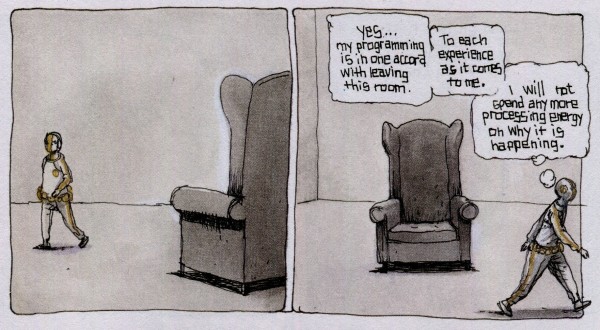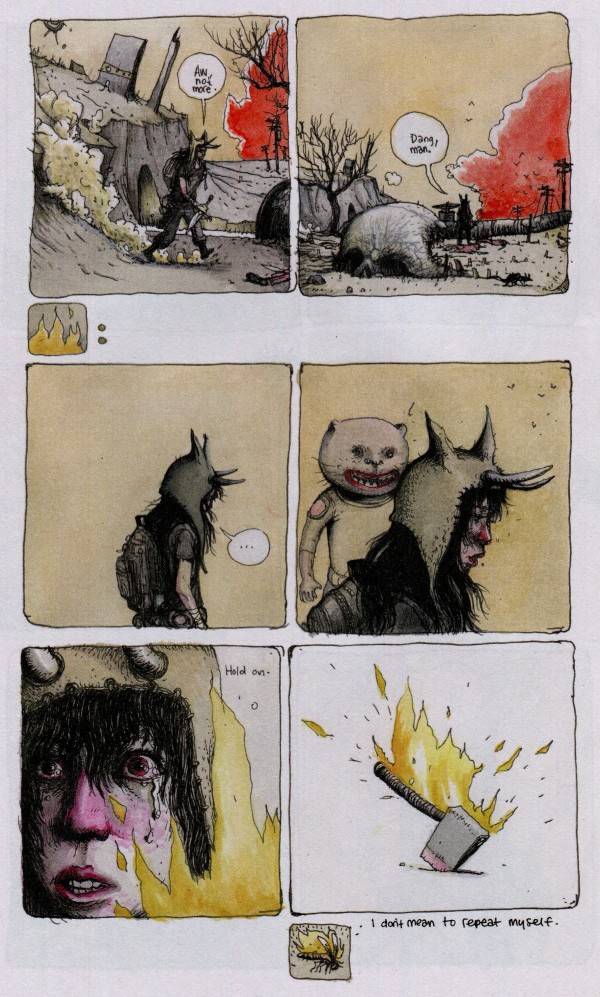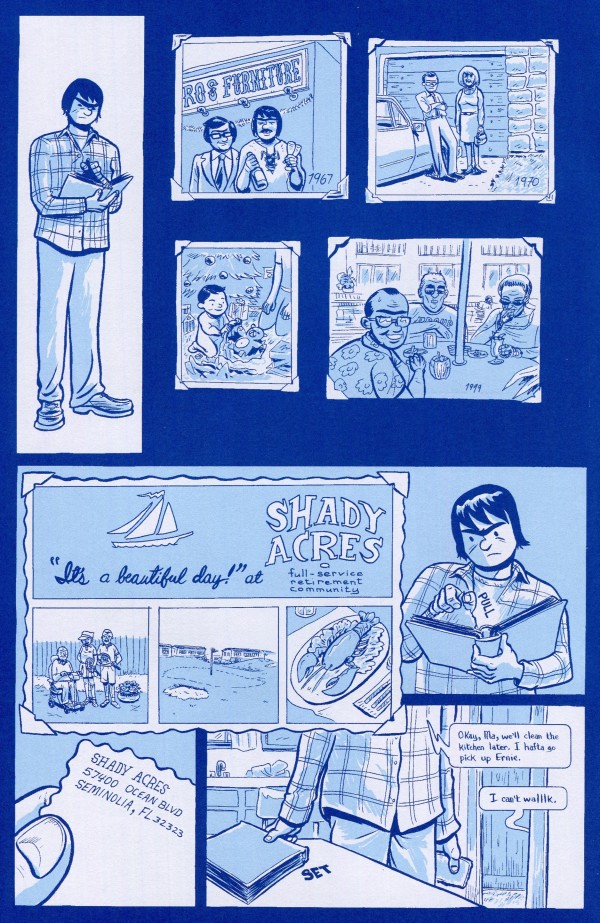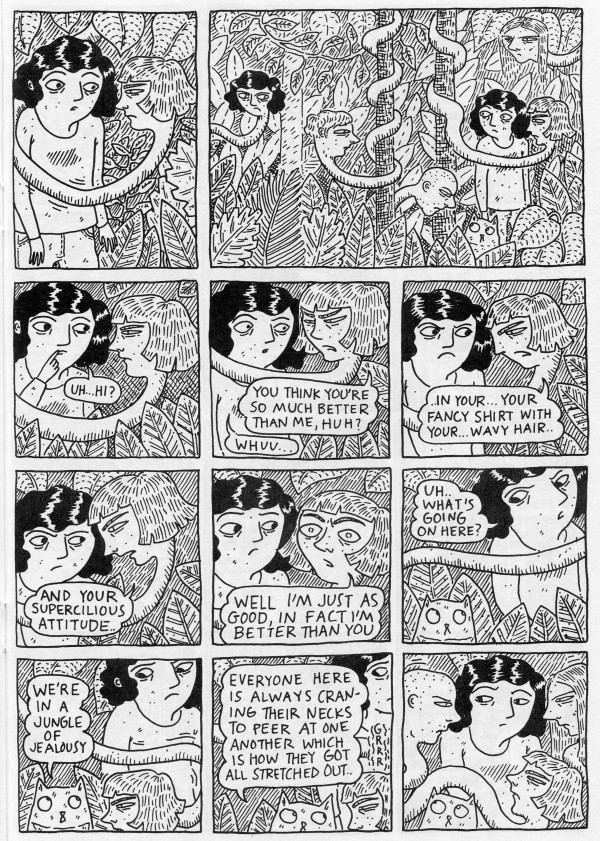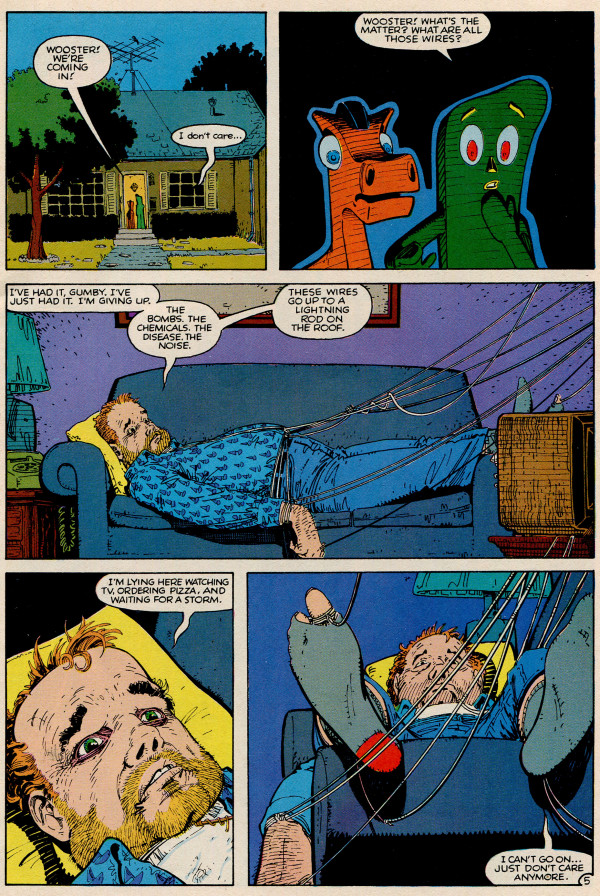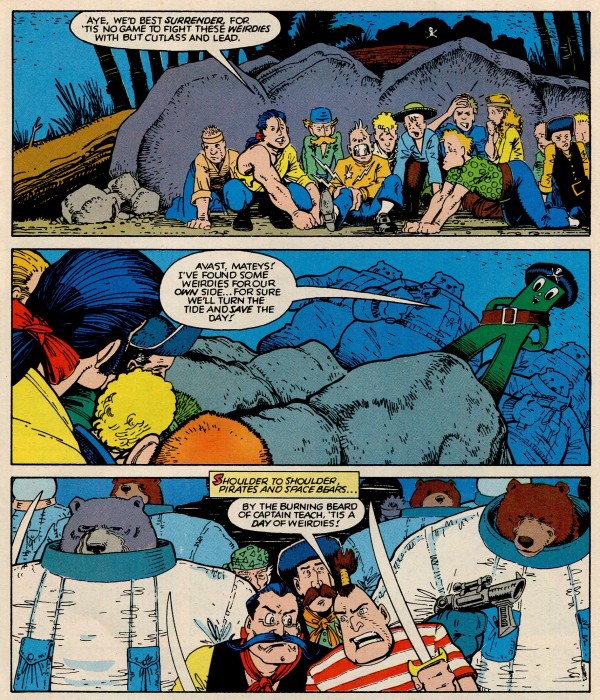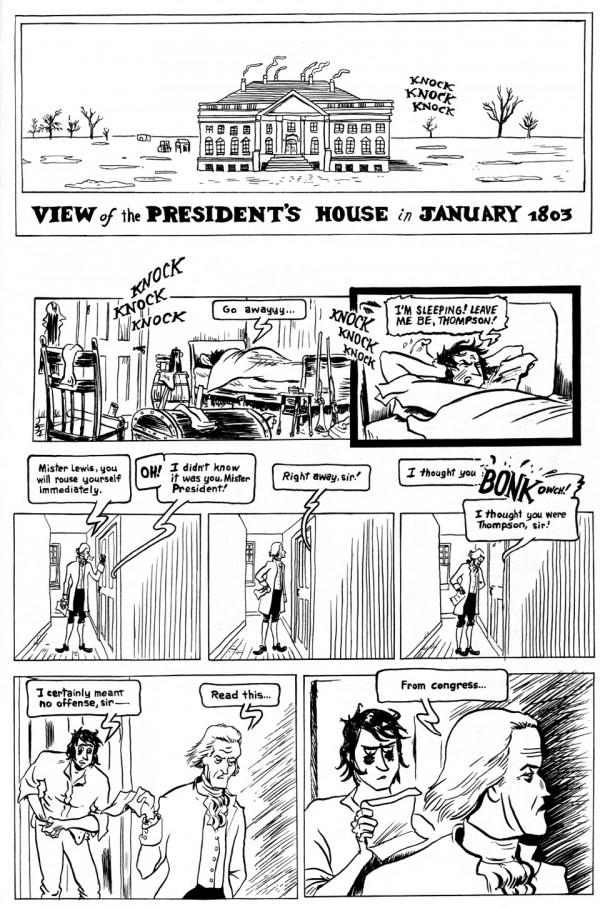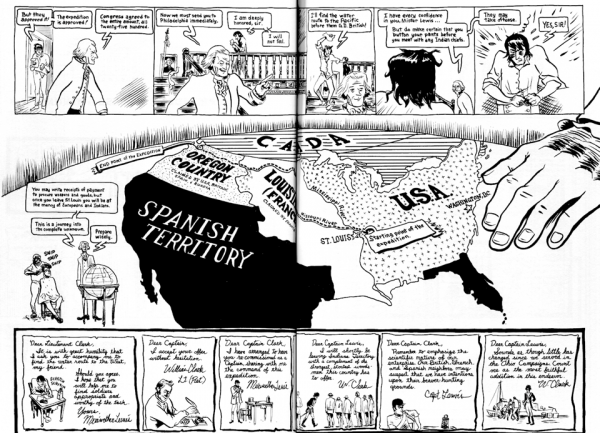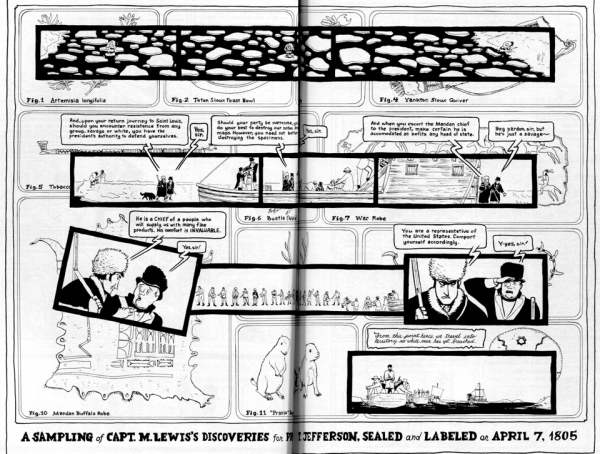What We’re Reading: It Will All Hurt, Rubber Necker, Debbie’s Inferno, Gumby

There were a few years of my twenties where I imagined myself to be on the forefront of a cultural war, and I was fighting for the validity of the comic book. “Graphic novel!” I might shout. “Mature themes!” I would rail. I filled my bookshelves with collected editions and hid my longboxes of monthly comics (floppies, pamphlets, stapled virions of trash culture) in the closet.
Luckily, I’m older now, and I can accept that comics can be many things: long or short, fiction or not, fast or slow, dense or breezy. In a world where short prose has to be lodged between magazine articles or tarted up as longer books (and priced as such), I’ve learned to celebrate the single comic issue. In exchange for a few dollars, I get an objet d’art that I can roll up in my pocket, store in a box, hang on a wall, and, above all, read. Here are some of the latest reasons for my celebration.
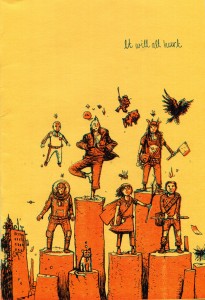 It Will All Hurt #1 & 2 by Farel Dalrymple (Study Group Comics, 2013-present)
It Will All Hurt #1 & 2 by Farel Dalrymple (Study Group Comics, 2013-present)
Farel Dalrymple’s ostensibly ongoing series is a poetic and flowing exploration of grappling with the world’s failure to align with what you imagined it could be. It’s at turns hopeful and dark, casual and ornate, fantastic and mundane. Dalrymple’s work is often dreamily told, and exposition is limited to the superficial classification of places and objects like one might encounter in a video game guidebook—that is, he’ll tell you what a character is called, but he’s not going to dump the whys and hows on you. He’s taking you on a ride, and he’s asking you to settle in and come with.
Scenes dissolve from one into another, leaking together as characters watch others on screens or hear them in their headphones. This blending extends to marks made on the page as well; words and designs and lonely ellipses hover outside of the panel borders. The white gutters, normally off limits in comic storytelling, become another place to play in, jump through, and float along.
The printing on these issues is what keeps pulling me back. The toxic neons of the cover give way to oversize pages filled immaculate watercolors that alternately bloat and burn in the sick, weird world that Dalrymple has created. Even the texture—thin but supple newsprint—feels like something you’d find after society has moved on.
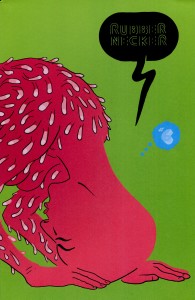 Rubber Necker #5 & 6 by Nick Bertozzi (self-published)
Rubber Necker #5 & 6 by Nick Bertozzi (self-published)
The one-person anthology used to be an apex of achievement for cartoonists. Chester Brown’s Yummy Fur, Daniel Clowes’s Eightball, and Chris Ware’s Acme Novelty Library, for instance, served as spaces for those cartoonists to explore a number of ideas, approaches, and narratives while still marking out a space that was expressly their own. These anthologies serialized stories that were eventually collected as “graphic novels,” and as more publishers pursued graphic novels without the testing arena of serialization, the one-person anthology dropped out of the spotlight.
Luckily, Nick Bertozzi hasn’t abandoned the format. In between making historical graphic novels and teaching at the School of Visual Arts, he’s been putting out issues of Rubber Necker since 2003. Each issue contains part of the serialized “Drop Ceiling,” perhaps the closest Bertozzi comes to the “sad man” genre that populated the anthologies of the nineties and aughts; “Drop Ceiling” is more engaging, though, as Bertozzi allows space for a variety of characters, a range of emotions, and even a bit of plotting that I would almost call “rollicking.”
The rest of the issues are filled out with a variety of gag strips, fake ads, weird meditations, and touching autobio. The colors are carefully considered and serve the stories well; “Drop Ceiling” has a shifting monochrome, and the shorts range from flat pastels to purposefully off-register printing.
An anthology is always a gamble, and the quality is guaranteed to fall within a range. With Rubber Necker, the range is “pretty good” to “artfully touching,” which is a great range.
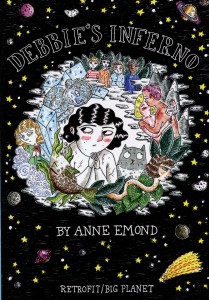 Debbie’s Inferno by Ann Emond (Retrofit, 2014)
Debbie’s Inferno by Ann Emond (Retrofit, 2014)
Allegory seems hard to do well. The blunt, one-to-one metaphorical ratio lends itself to obvious and heavy-handed stories. Anne Emond’s Debbie’s Inferno is an exception to that, though. Debbie and her cat explore the landscape wrought from her worries (The Jungle of Jealousy, The Land of Cold Fish, The Mountains of No Atmosphere), and Emond renders the extreme terrain with the same sure line as Debbie herself is drawn in. This effect manages to make the landscape simultaneously fantastical and mundane, which matches the effect these sorts of feelings have on people—they are huge, affecting, and devastating, but they’re also familiar and universal.
The scale of these feelings can be overwhelming, and the “sad man” genre of comics mentioned above often ratcheted that scale into a sort of mopey selfishness that cast everything outside of the protagonist in a gray supporting role. By acknowledging the universality of these feelings, Debbie’s Inferno invites readers to pass through the anxieties at Debbie’s side, with Debbie acknowledging how difficult life can be while her cat urges her (and us) along so that we can rejoin the world.
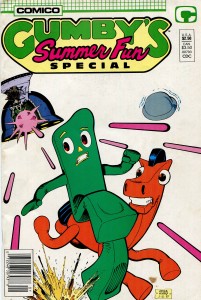 Gumby’s Summer Fun Special by Bob Burden & Art Adams (Comico, 1987)
Gumby’s Summer Fun Special by Bob Burden & Art Adams (Comico, 1987)
Coming at you from the summer of 1987, Gumby’s here to take you far away from those weighty feelings of depression and fear!
(It gets more fun. I promise.)
With art by Art Adams, who, in 1987, was fresh off of drawing wildly popular issues of X-Men and New Mutants, and written by Bob Burden, who is maybe most famous for doing a comic that was adapted into the 1999 movie Mystery Men with Ben Stiller and Janeane Garofalo, this Gumby special is a weird thing.
Adams pretty much spawned the hyper-rendered drawing style that went to dominate superhero comics throughout the nineties and beyond, and seeing the sleek, simple form of Gumby dashing around with pirates, aliens, and robots drawn in Adams’s traditional, line-filled style creates a strange dissonance.
It’s not necessarily helped by the loping gait of the story. The plot doesn’t escalate and resolve in a traditional way. Instead, it just kind of jumps along from one oddity to the next. It’s almost picaresque in the way Gumby and Pokey tumble along from one set piece to the next.
Luckily, no one goes to Gumby’s Summer Fun Special for a tight plot and sleek visuals. They go to Gumby for the weirdies, and that’s exactly what Burden and Adams deliver. It’s a palate cleanser and an empty calorie. It’s that stapled virion of trash culture that I found for a dollar at an antique store, and the novelty is worth every penny.
Are comics the last refuge of cheap culture to consume? What are your cheap not-quite-guilty pleasures?

 Lewis & Clark by Nick Bertozzi (First Second, 2011)
Lewis & Clark by Nick Bertozzi (First Second, 2011)
Nonfiction comics are always a mixed bag, and my beef is that, for the lion’s share of them, the comic format is simply a novelty to be draped over some information; it’s a spoonful of sugar to take with your medicine. Instead of cursing the darkness, though, I’d like to hold a candle to one of my favorite examples of historical comics: Nick Bertozzi’s Lewis & Clark.
Never heard of it? It probably got lost in the waves of boring, educational comics I mentioned above. Amazon recommends it for ages 12-17, and the book’s cover blurb is a symptom of that kind of thinking; from the venerable Ken Burns, we see that this book is “[a] wonderful introduction to one of the most important expeditions and dramatic stories in American history.” It’s not the dramatic story—it only serves as an introduction.
Obviously, I think Lewis & Clark is a bit more than an introduction to the historical expedition. It’s closer to a biography of Captain Merriwether Lewis and a devastating portrait of manic depression. But it’s fun! And exciting! If someone told me a comic was “a devastating portrait of manic depression,” I’d steer clear, but I promise this book is worth it. The narrative is cunningly crafted, and Bertozzi takes advantage of the comic medium in ways both subtle and flamboyant.
A dry, didactic introduction to this important expedition might start with some historical context. It might establish what was happening in the United States and France or elucidate the borders of the fledgeling U.S. Instead, we’re introduced to the moody yet sedentary Merriwether Lewis. Bertozzi shows us right away who his story is focusing on.
He also isn’t lazy about setting the scene. A lesser cartoonist sticks a small narrative box in the corner above Lewis to tell us where and when we are. Bertozzi gives us a lovingly lettered postcard of the president’s home, simultaneously teaching us how he’s going to take us from scene to scene.
Bertozzi doesn’t skimp on the context and the elucidation, though—he doesn’t sacrifice history for character development. He just informs us in a way that expands on character. We don’t get a map; we get a close-up on a globe, Jefferson’s hand resting in the east. It’s a calm hand, but it’s also huge and a little threatening. In the background, Lewis gets a haircut. It’s a sad man who needs other men to prompt him towards grooming.
This foregrounding of Lewis’s personality over the intricacies of the expedition and the quirks of the period is illustrated quite literally in one case:
The facts and the methods, illustrated in the background, are interesting, but an explanation of what they mean might be more fitting for a textual analysis. It’s the personality and the human element that Bertozzi captures best with his thick, loose line. The pages above show him getting the best of both worlds: the collection and display of objects and facts, like a comic book Wunderkammer, along with the primal emotion that cartooning does so well.
While Lewis is central to the arc that Bertozzi’s constructed, everyone gets a bit of definition, and it’s Bertozzi’s familiarity with the tools of comic storytelling that make this possible. For instance, this book is a showcase for thoughtful, deliberate lettering. Each specific language is rendered in a different style, intuitively signalling the change in tongue without needing intrusive footnotes.
The biggest evidence for this being the story of temperamental Merriwether Lewis’s comes about a third of the way through the book with the first sighting of the Pacific. It’s given a bit of visual weight, but not more than any other location the Corps of Discovery visits. Two pages are devoted to Sacagawea’s peaceful exploration of the beach, but Lewis has an entirely different reaction: the achievement sends him into another deep malaise similar to how he was when the book began.
Why? What’s the source of Lewis’s emotional rise and fall? The people around him call him “temperamental” and “dark,” and Bertozzi is smart enough to let that stand as the sole diagnosis. His moods are mysterious and sudden, and the most definition they get is when Bertozzi illustrates them as ominous shadows just out of reach.
